This post may contain affiliate links. If you buy something from one of our links we may earn a commission. Thanks
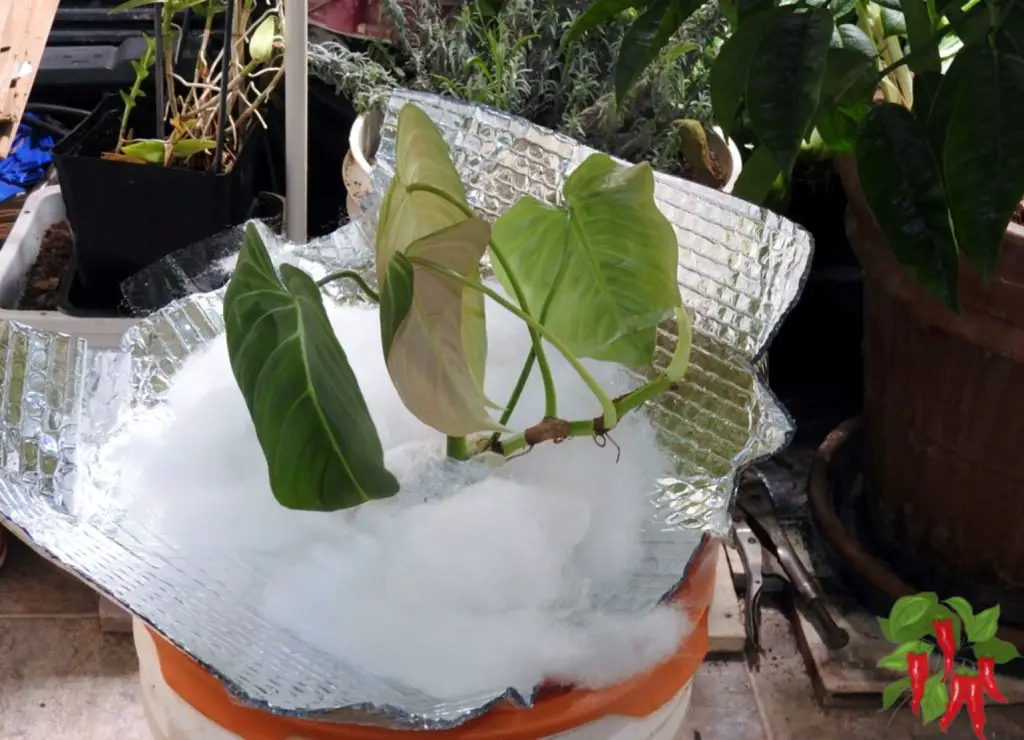
When it comes to Philodendron Glorious care, it’s all about ensuring your plant thrives and shines.
Well howdy, everyone! This unique hybrid is a climber, not a crawler, so it needs a bit of special attention to its support and watering.
By understanding its specific needs, you’ll help it flourish beautifully, turning it into a true standout in your indoor garden.
Philodendron Glorious Care Key Takeaways
- Philodendron Glorious care involves using a coco coir and perlite mix,
- A support pole for climbing, and regular watering.
- Ensure the plant is potted at the same depth
- Provide a self-watering system to keep the support moist.
- This approach promotes healthy growth and vibrant foliage.
Philodendron Glorious Care Unboxed and Potted Up
Well howdy everyone. I just received a Philodendron glorious. Not to be confused with a Philodendron gloriosum. This plant is a climber and I will be using it with my new Self Watering Coco Coir Support Pole – Stay Green Gardens.
The plant arrived in pretty good shape. It’s in a root ball. So, I will come back in a minute and show it being repotted. And we’ll go from there.
So, here we have my Philodendron Glorious. I have a pot here to transplant it in, and I have some soil mix here.
Philodendron Glorious vs Gloriosum
The Philodendron Glorious is a hybrid of the Philodendron gloriosum and the Philodendron Melanochrysum.
It is often confused with Philodendron gloriosum which is a creeping Philodendron.
But the Glorious Philodendron is a hybrid that climbs rather than crawls. And it is the plant I will be growing.
What is an Aroid
Many popular houseplants come from this family including Monsteras, Philodendrons, Anthurium, Alocasia, Aglaonema, and Pothos
The Araceae are a family of monocotyledonous flowering plants in which flowers are borne on a type of inflorescence called a spadix. The spadix is usually accompanied by, and sometimes partially enclosed in, a spathe (or leaf-like bract). Also known as the arum family, members are often colloquially known as aroids. This family of 114 genera and about 3,750 known species is most diverse in the New World tropics, although also distributed in the Old World tropics and northern temperate regions. Wikipedia
Aroid Soil Mix
Now a lot of people talk about a special aroid mix, and they even sell commercial aroid mixes. They often complicate it by making it four or five parts, but to tell you the truth, coco coir, and perlite will work just fine.
You don’t need anything else. So keep things simple and use 25-33% perlite mixed into your coco coir. You can add some compost or better yet worm castings to the mix.
My Soil Mix
We have this plant here and I’m going to fill this pot up with coco coir. So, we’ve got the pot full of coco coir and You can see in the video that I have, these grow stones mixed in.
It is kind of like perlite, but they’re made from recycled glass. I don’t know if you can get them anymore, but I have them, so I’m going to use them.
And so, we have this plant, and we need to unpot it from this plastic wrap. Okay, so, it’s in plastic wrap, and then it’s in a paper towel. So, let’s get all this off. It looks like it’s got pretty healthy roots.
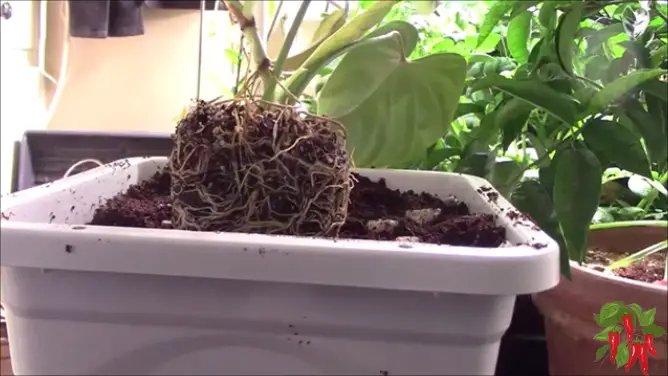
We’re gonna set it in my pot right about in the middle of the pot and at the same depth it previously grew.
I don’t know if you can see them in the video, but this plant already kind of has aerial roots on it, which can be tied to a plant support.
And basically, what I’m going to do is put one in the middle. So, I’m going to put on this stabilizer on the bottom, and we’re gonna poke this support pole into the soil. And so, the plant is right alongside this coco coir support pole.
Self Watering Coco Coir Support Pole
Self-Watering, Extendable Coco Coir Pole for Climbing Plant Support
Climbing plants like Monsteras and Philodendrons produce aerial roots that can be trained to a support pole.
These plants can get quite large. But this training method allows you to grow them vertically which can help save space especially if you live in an apartment.
Read my article: Self Watering Coco Coir Support Pole – Stay Green Garden
Here is the video:
Tying Up The Stem
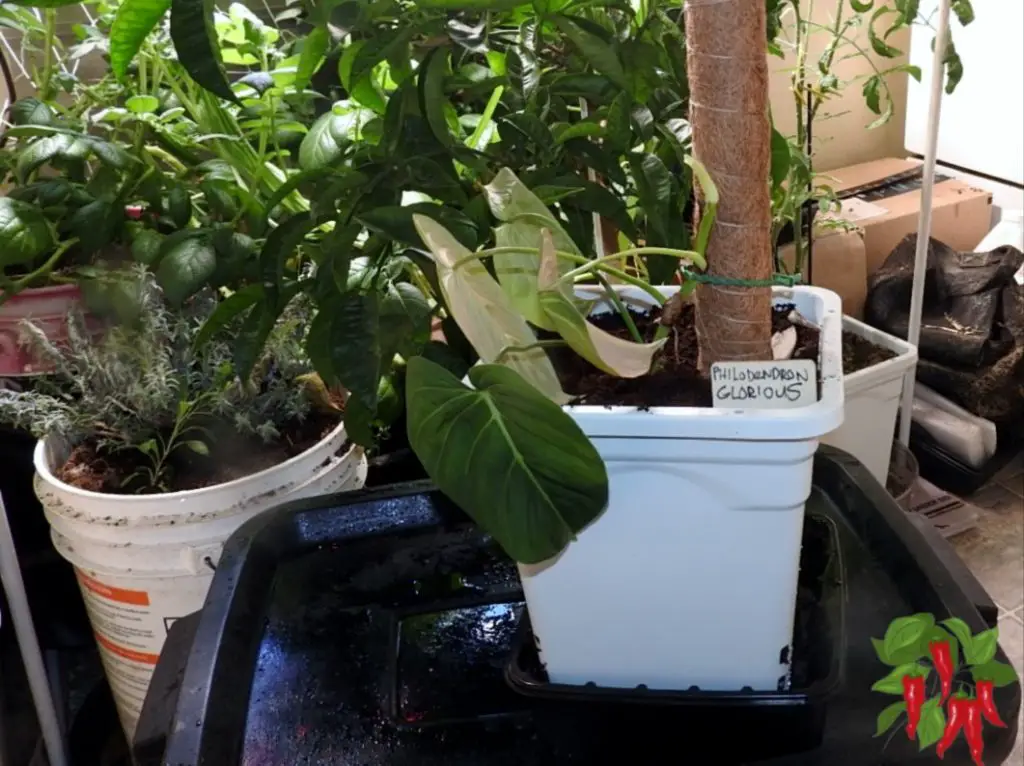
Now, what I’m gonna do, is I have these ties here. So, I’ve got this zip tie here. I’m going to attach it to the coco coir support post.
So, we have this stem loosely attached. And it will root into this coco Coir support eventually. I think I’m just going to let the other leaves hang down from the bottom.
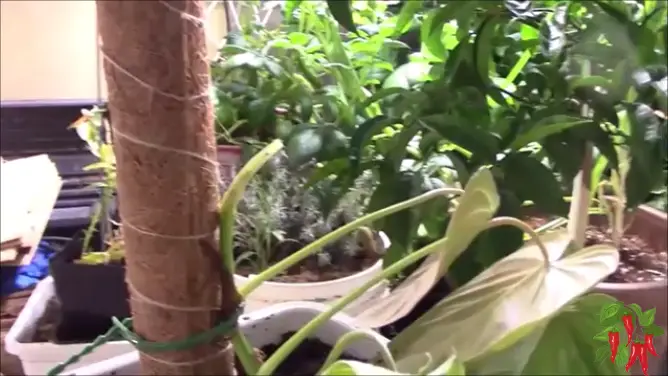
And that will be the new growth point right there up on top. So what you do, is you water this through the funnel, and then the water runs down the cocoa core support and also into the pot.
And as it climbs, you continue to tie it. Now, one of the things that I’ve seen is a lot of plants are tied just flat and they seem to only have leaves on one side and I don’t like that look
So I’m going to try to spiral this growth around the support post itself and then when it gets taller I’ll add another section.
Philodendron glorious Final Thoughts
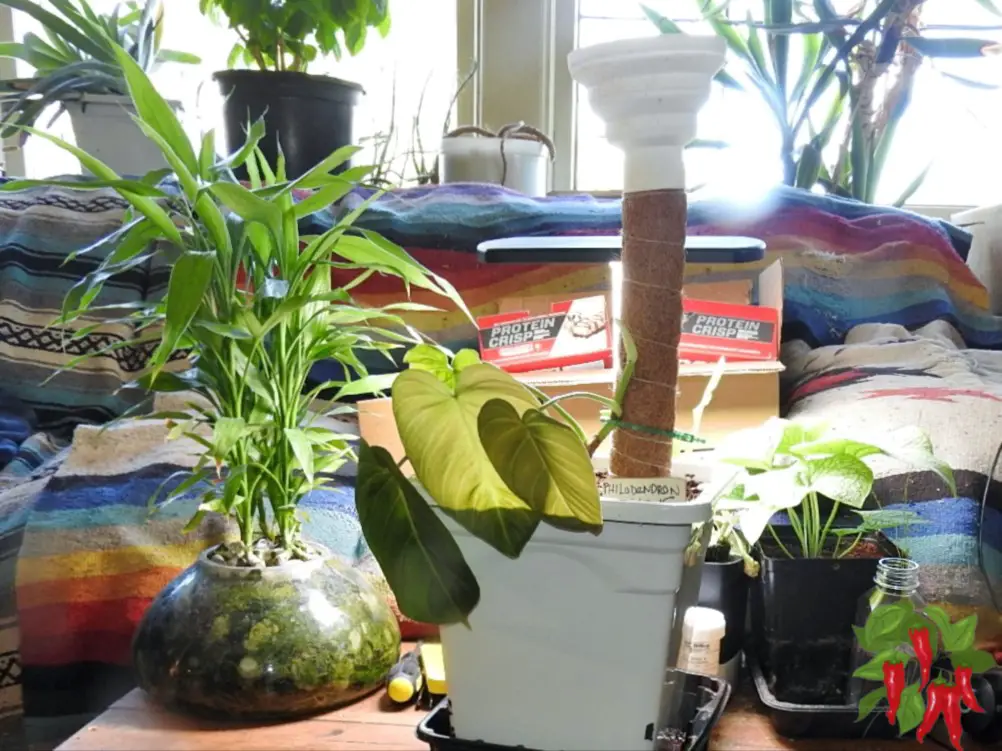
So this is my Philodendron glorious. And remember, it’s different than the Philodendron gloriosum, which is a crawling philodendron.
So you want to make sure when you use this, you’ve got a climber. And you can use it for lots of other plants like Pothos too.
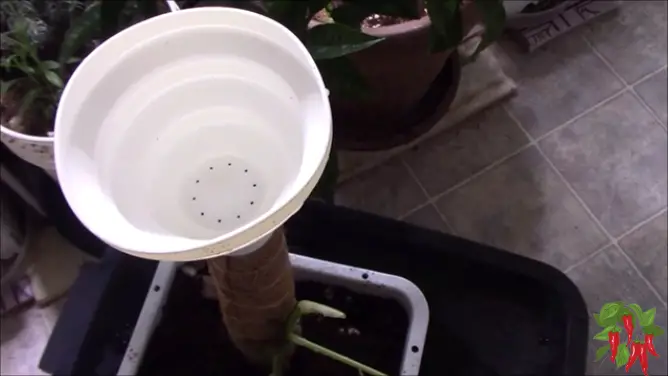
So it took about four quarts of liquid and the post is getting moist. I think what I’ll do from now on is soak these first and I’m going to probably go over this and spray it with a mist just to get it really moist.
And that’s it. Once it’s moist all you have to do is give it a little bit of water every week to keep it going.
And if the pot does really start to dry out, You’ll want to water the pot itself.
FAQs: Philodendron Glorious Care
Howdy everyone! If you’re curious about caring for your Philodendron Glorious, you’re in the right place. Let’s dive into some frequently asked questions to help you keep this stunning plant thriving.
Q: What is a Philodendron Glorious?
A: The Philodendron Glorious is a hybrid plant, a cross between the Philodendron Melanochrysum and the Philodendron Gloriosum. It combines the velvety texture and elongated form of the Melanochrysum with the large, veined leaves of the Gloriosum, making it a unique and attractive houseplant.
Q: How do I care for a Philodendron Glorious?
A: Philodendron Glorious care involves providing bright, indirect light, watering when the top inch of soil feels dry, and maintaining high humidity levels. Use a well-draining potting mix, such as a blend of coco coir and perlite. Support the plant with a moss pole or coir totem to help it climb.
Q: When should I repot my Philodendron Glorious?
A: Repot your Philodendron Glorious when its roots outgrow the current pot, typically indicated by roots protruding from drainage holes or circling at the soil’s surface. Spring and early summer are the best times for repotting, as the plant is actively growing.
Q: What kind of fertilizer should I use?
A: Use a balanced, urea-free fertilizer during the growing season (spring and summer). Fertilize once a month and dilute the fertilizer according to the package instructions to avoid root burn. Avoid fertilizing during fall and winter when the plant’s growth slows down.
Q: Can I grow Philodendron Glorious outdoors?
A: Yes, you can grow Philodendron Glorious outdoors in a shaded location during the summer. However, it does not tolerate frost, so bring it indoors when nighttime temperatures drop to around 50°F (10°C).
Q: How can I increase humidity for my Philodendron Glorious?
A: To increase humidity, you can group your plants together, mist them, use a pebble tray, or invest in a humidifier. Ensuring a humidity level between 60-80% is ideal for this tropical plant.
Q: What are common problems with Philodendron Glorious?
A: Common problems include yellowing leaves due to overwatering or poor drainage, and root rot caused by excessively soggy soil. Ensure proper watering routines and use well-draining soil to prevent these issues.
By following these care tips and addressing common concerns, you can enjoy the lush, velvety beauty of your Philodendron Glorious.
Philodendron Glorious Care Conclusion
Caring for your Philodendron Glorious can be a rewarding experience, especially with the right techniques and knowledge. Here’s a summary of the key points discussed:
Key Takeaways
- Proper Soil Mix: Use a blend of coco coir and perlite.
- Support System: Utilize a self-watering coco coir support pole for climbing.
- Watering: Regularly water the support pole and the pot to maintain moisture.
- Plant Positioning: Ensure the plant is potted at the correct depth with aerial roots tied to the support.
- Growth Maintenance: Spiral the growth around the support pole for an even look.
By following these tips, your Philodendron Glorious will thrive, adding lush greenery to your indoor space. Happy gardening, and remember to stay green!
So take good care of yourselves. Happy gardening. Don’t forget, stay green. All right, see y’all later.
Visit my Amazon Influencer Page for videos and gardening products Grow Your Own Garden







